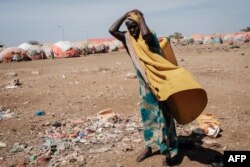Aid agencies warn the number of people facing starvation in the Horn of Africa is expected to reach 20 million by the end of September without a stronger response to an ongoing drought.
The warning comes after the fourth rainy season in a row for the region without adequate rain. The worst drought in 40 years has killed more than seven million livestock across Ethiopia, Kenya and Somalia.
In some parts of East Africa, communities have not seen significant rainfall for the past two years.
Yusuf Guure, 67, who lives in northeastern Kenya, said he has lost 294 animals to drought.
"We have never seen such a persistent drought, a drought that has wiped out pasture and a drought that has left animals with nothing to feed," he said, adding, "Where do you get that money to feed them and you are unemployed?"
Shashwat Saraf is the regional emergency director for East Africa with the International Rescue Committee. He said pastoral communities living in Ethiopia, Kenya and Somalia are feeling the effects of the drought, and that millions are on the move in search of water, food and pasture.
"We are seeing anywhere between 60 to 100 percent loss of livestock, which is a mainstay for the population because they lost their only source of livelihood," he said. "We are seeing massive displacement happening of households and people moving to urban centers or moving to other locations and to find ways to make their household food secure."
Agencies say that since mid-2021, one-third of all livestock in Somalia has died and 3.6 million livestock have died in Ethiopia and Kenya.
Alyona Synenko, regional spokesperson for the International Committee of the Red Cross, said Somalia is the most affected country of the three and decades of conflict have complicated the situation for those suffering and for aid agencies.
"The needs are extremely high and sometimes you look at people and you see people who are displaced and they lost everything," she said. "So it's difficult to say that people are getting the help they need because their needs are so important. We also speak about a crisis that is one of the most protracted crises in the region and there is also a level of donor fatigue, especially when there is so much competition for the humanitarian funds, so sometimes we have to make very difficult choices."
The combination of harsh weather and rising food and fuel prices has made the humanitarian outlook worrisome for months to come.
The U.N. humanitarian office, UNOCHA, said Somalia is at risk of famine, and more than 80,000 people are experiencing extreme hunger. Officials also said Tuesday that severe acute malnutrition is on the rise across the three countries and poses an immediate threat to children's lives.
The U.N. and aid agencies have reached 6.5 million people in the affected areas with food, water and health services. They warn more funding and food are needed to save lives in the coming months.











